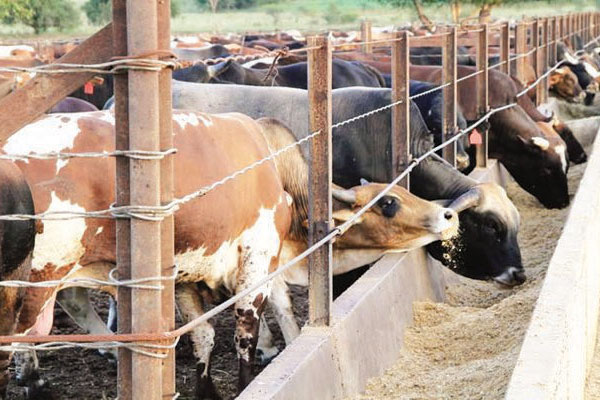

BY MTHANDAZO NYONI
Half of Zimbabwe’s national herd is at risk of being wiped out by drought if no mitigatory measures are put in place to avert the situation, farmers and livestock experts have warned.
The national herd is estimated to be 5,2 million, but the future of the livestock industry is very bleak owing to diseases, critical shortages of stockfeed and dipping chemicals as well as the devastating effects of the El Nino-induced droughts.
Pastures have depleted while water bodies are drying up in most parts of the country, leaving animals — both wild and domestic — fighting for survival.
The southern African nation did not receive adequate rainfall during the 2018/19 agricultural season due to El Nino.
Livestock farmers who spoke to Standardbusiness last week said there was need for urgent intervention to avert a catastrophic situation.
“As livestock farmers, we know and we can see that it’s going to be a bad year.
“It could be catastrophic, especially if there are no mitigatory measures put in place.
- Chamisa under fire over US$120K donation
- Mavhunga puts DeMbare into Chibuku quarterfinals
- Pension funds bet on Cabora Bassa oilfields
- Councils defy govt fire tender directive
Keep Reading
“If government does not intervene, farmers would not be able to manage the situation on their own.
“In the next two months, water and pastures would dry up,” Livestock Farmers’ Union chairperson Sifiso Sibanda said.
“According to our assessment, if no mitigatory measures were put in place to avert the situation, we are likely to lose about 50% of the country’s national herd. Government should declare the situation a national disaster.”
To make matters worse, Sibanda said, stockfeed, vaccines and dipping chemicals were too expensive and beyond reach for many farmers.
The Stockfeed Manufacturers’ Association of Zimbabwe said, in a newsletter, that the general non-availability of raw materials had resulted in some stockfeed producers being unable to fulfil orders by non-governmental organisations for survival stockfeeds.
The association also noted that the price of high crude protein cotton cake had increased drastically from RTGS$400 to RTGS$1 200 between January and March, and molasses, wheat and maize brans were in short supply.
“Farmers could consider selling a few of their animals, especially those that are old, so that they can buy dipping chemicals, vaccines and stockfeed.
“We are not talking of destocking. No, we have not gone that far,” Sibanda said.
Matabeleland South crop and livestock officer Simangaliphi Ngwabi said drought mitigation strategies are required to save the livestock.
“Livestock is currently in good condition but that would be for a temporary period,” she said.
“Pastures are fast depleting and water bodies are drying up. If we had water, it was going to be better.
“Farmers should assess the situation and come up with a solution.
“They can reduce their herds to manageable numbers or even sell some of their livestock and buy stockfeed.
“If they fail to get supplementary feed their livestock, chances are high that they might succumb to drought.”
Matabeleland North crop and livestock provincial officer Dumisani Nyoni said all districts in the province did not have enough pastures as well as water.
“Almost all the districts will run out pastures by July or mid-August. There is no water and animals would start competing for water with humans. That will make boreholes breakdown constantly or run dry quickly,” he said.
Nyoni urged farmers to sell some of their animals and buy supplementary feed or dig wells for watering them.
“If it’s possible, at national level, government should come up with a programme to assist farmers to access stockfeed easily and at affordable prices. As we speak, the stockfeed is not affordable,” he said.
The situation is also dire in Midlands province, with the worst affected districts being Mberengwa, Zvishavane, Kwekwe and Gokwe North.
Masvingo lost about 40 000 cattle to drought last year and if no significant measures are put in place, the province might suffer again.
A veterinary expert, who requested anonymity, urged farmers to start feeding their animals immediately before their condition deteriorates.
“Farmers can start feeding their livestock now, they should not wait until September when the situation gets worse. They should also make sure that their animals do not walk long distances in search of pastures and water because that would exhaust them,” the official said.
The province is home to an estimated of 500 000 head of cattle, but they are under threat of depletion from effects of drought.
Despite recurrent droughts that have seen the national herd diminishing, the government does not have programmes to combat effects of drought on livestock.
Agriculture plays a key role in Zimbabwe, contributing 11% to the total gross domestic product and remains the main source of livelihood for around 67% of the country’s population.
Hence, its demise would spell disaster on the economy.
Land, Agriculture, Water, Climate and Rural Resettlement deputy minister Vangelis Haritatos said the ministry was looking into urgently drilling boreholes at strategic places in order to solve the water problem caused by the current drought.
“It is important to note also that this programme will have a double benefit as it will also stop cattle from straying into neighbouring countries, such as Botswana, in search of water,” Haritatossaid.
He said the Department of Veterinary Services had already vaccinated cattle in drought-stricken, low-risk foot-and-mouth disease (FMD) areas to allow them to move to FMD red zones for relief grazing.
“This is critical in order to ensure that they do not get FMD when they mix with buffalo.
“We try our best to ensure that red zone cattle are always vaccinated against FMD.
“We are grateful to our partners for also supporting our initiative by supplying survival feed to the hardest-hit areas at reduced prices,” he said.
“We would also like to highlight that livestock can be a lucrative business if managed correctly.
“In times of drought we encourage our farmers, through our extension officers, to destock slightly in order to be able to generate funds in order to purchase feed to ensure that the remaining livestock stay healthy and productive.”
Haritatos said it was best to have nine healthy and productive head of cattle than to have 10 dead cattle.
“Furthermore, we want to discourage people from burning grass, in particular in provinces that have had better rains, but to instead cut the grass and make hay bales in order to export to other provinces that are in dire need of feed,” the deputy minister said.
“As a ministry, we are also looking into assembling hay bailing units (tractors, slashers, racks, and hay balers) in order to assist with the same concept. Hay is one example, but broadly speaking, going forward, we are encouraging our farmers to grow fodder in provinces that have better rainfall than some of our drier provinces.”
He described fodder as a great benefit to the animal through nutrients because it is like fresh pastures.
“It is easier to digest, helps with weight gain, increases life expectancy especially with dairy cows, increases yield of milk, and, of course, increases the hoof health of the animal, which generally benefits the health of the animal, which is of critical importance to our ministry,” he said. “Also remember that fodder is a cost-effective option for our farmers.”
Haritatos also said farmers needed to consider silage, which is also extremely important because it involves preserving the food for the animal, which could then be used during dry times.
“The concept here is that of cross-trade between provinces. For example, Mashonaland West grows feed and exports to dry areas such as Gokwe to feed livestock,” he said. “Farmers in Gokwe then sell their meat to Mashonaland West province.”











